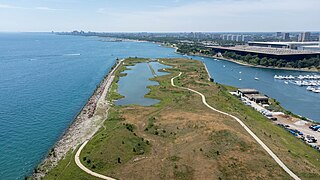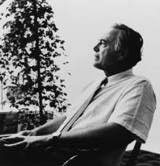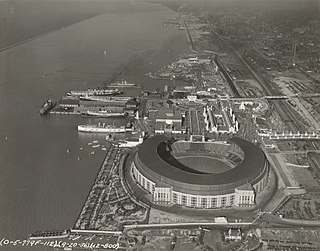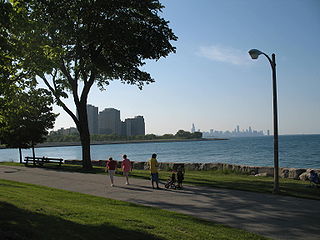Related Research Articles

The World's Columbian Exposition, also known as the Chicago World's Fair, was a world's fair held in Chicago from May 5 to October 31, 1893, to celebrate the 400th anniversary of Christopher Columbus's arrival in the New World in 1492. The centerpiece of the Fair, held in Jackson Park, was a large water pool representing the voyage that Columbus took to the New World. Chicago won the right to host the fair over several competing cities, including New York City, Washington, D.C., and St. Louis. The exposition was an influential social and cultural event and had a profound effect on American architecture, the arts, American industrial optimism, and Chicago's image.

A Century of Progress International Exposition, also known as the Chicago World's Fair, was a world's fair held in the city of Chicago, Illinois, United States, from 1933 to 1934. The fair, registered under the Bureau International des Expositions (BIE), celebrated the city's centennial. Designed largely in Art Deco style, the theme of the fair was technological innovation, and its motto was "Science Finds, Industry Applies, Man Conforms", trumpeting the message that science and American life were wedded. Its architectural symbol was the Sky Ride, a transporter bridge perpendicular to the shore on which one could ride from one side of the fair to the other.

A world's fair, also known as a universal exhibition, is a large global exhibition designed to showcase the achievements of nations. These exhibitions vary in character and are held in different parts of the world at a specific site for a period of time, typically between three and six months.

The Louisiana Purchase Exposition, informally known as the St. Louis World's Fair, was an international exposition held in St. Louis, Missouri, United States, from April 30 to December 1, 1904. Local, state, and federal funds totaling $15 million were used to finance the event. More than 60 countries and 43 of the then-45 American states maintained exhibition spaces at the fair, which was attended by nearly 19.7 million people.

The Bureau International des Expositions is an intergovernmental organization created to supervise international exhibitions falling under the jurisdiction of the Convention Relating to International Exhibitions.

The 1982 World's Fair, officially known as the Knoxville International Energy Exposition (KIEE) and simply as Energy Expo '82 and Expo '82, was an international exposition held in Knoxville, Tennessee, United States. Focused on energy and electricity generation, with the theme Energy Turns the World, it was officially registered as a "World's Fair" by the Bureau International des Expositions (BIE).

Fair Park is a recreational and educational complex in Dallas, Texas, United States, located immediately east of downtown. The 277-acre (112 ha) area is registered as a Dallas Landmark and National Historic Landmark; many of the buildings were constructed for the Texas Centennial Exposition in 1936.

Jackson Park is a 551.5-acre (223.2 ha) urban park on the shore of Lake Michigan on the South Side of Chicago. Straddling the Hyde Park, Woodlawn, and South Shore neighborhoods, the park was designed in 1871 by Frederick Law Olmsted and Calvert Vaux and remodeled in 1893 to serve as the site of the World's Columbian Exposition. It is one of the largest and most historically significant parks in the city, and many of the park's features are mementos of the fair—including the Garden of the Phoenix, the Statue of TheRepublic, and the Museum of Science and Industry.

Northerly Island is a 119-acre (48 ha) human-made peninsula and park located on Chicago's Lake Michigan lakefront. Originally constructed in 1925, Northerly Island was the former site of the Century of Progress world's fair and later Meigs Field airport and, since Meigs Field's closure, has been a recreational area part of Chicago's Museum Campus. It is the site of the Adler Planetarium, the Huntington Bank Pavilion, the Northerly Island Natural Area, the 12th Street Beach and numerous art installations. Per its name, Northerly Island was constructed as an island, but is connected to the lakefront by a causeway at the northern end carrying Solidarity Drive to the planetarium.

Parks in Chicago include open spaces and facilities, developed and managed by the Chicago Park District. The City of Chicago devotes 8.5% of its total land acreage to parkland, which ranked it 13th among high-density population cities in the United States in 2012. Since the 1830s, the official motto of Chicago has been Urbs in horto, Latin for "City in a garden" for its commitment to parkland. In addition to serving residents, a number of these parks also double as tourist destinations, most notably Lincoln Park, Chicago's largest park, visited by over 20 million people each year, is one of the most visited parks in the United States. Notable architects, artists and landscape architects have contributed to the 570 parks, including Daniel Burnham, Frederick Law Olmsted, Jens Jensen, Dwight Perkins, Frank Gehry, and Lorado Taft.

The Midway Plaisance, known locally as the Midway, is a public park on the South Side of Chicago, Illinois. It is one mile long by 220 yards wide and extends along 59th and 60th streets, joining Washington Park at its west end and Jackson Park at its east end. It divides the Hyde Park community area to the north from the Woodlawn community area to the south. Near Lake Michigan, the Midway is about 6 miles (10 km) south of the downtown "Loop". The University of Chicago was founded just north of the park, and university buildings now front the Midway to the south, as well.

The 1984 Louisiana World Exposition was a world's fair held in New Orleans, Louisiana, United States. It was held 100 years after the city's earlier world's fair, the World Cotton Centennial in 1884. The fair was held from May 12 to November 11, 1984, and adopted the theme "The World of Rivers: Fresh Water as a Source of Life," showcasing the vital role of freshwater systems.

Expo '74, officially known as the International Exposition on the Environment, Spokane 1974, was a world's fair held May 4, 1974, to November 3, 1974, in Spokane, Washington in the northwest United States. It was the first environmentally themed world's fair and attended by roughly 5.6 million people. The heart of the fair park grounds was located on Canada Island, Havermale Island, and the adjacent south bank of the Spokane River, comprising present-day Riverfront Park, in the center of the city.

Harry Mohr Weese was an American architect who had an important role in 20th century modernism and historic preservation. His brother, Ben Weese, is also a renowned architect.

The Great Lakes Exposition was held in Cleveland, Ohio, in the summers of 1936 and 1937, along the Lake Erie shore north of downtown. The fair commemorated the centennial of Cleveland's incorporation as a city. Conceived as a way to energize a city hit hard by the Great Depression, it highlighted the progress that had been achieved in the Great Lakes region in the last 100 years and indicated the path for future progress. Covering over 135 acres of Cleveland's lakefront, it featured numerous attractions, including rides, sideshows, botanical gardens, cafes, art galleries, and much more. Similar to the Chicago World's Fair, the exposition also wanted to expose visitors to other countries' cultures, celebrate American industry, and promote local businesses. Although the Great Lakes Exposition was not as much of a world fair as the Chicago World's Fair was, the exposition drew 4 million visitors in its first season, and 7 million by the end of its second and final season in September 1937—a total of 13 million visitors.

The Chicago Park District is one of the oldest and the largest park districts in the United States. As of 2016, there are over 600 parks included in the Chicago Park District as well as 27 beaches, 10 boat docking harbors, two botanic conservatories, a zoo, 11 museums, and one stadium. The Chicago Park District also has more than over 230 field houses, 78 public pools, and dozens of sports and recreational facilities, with year-round programming. It also owns and operates the lakefront stadium, Soldier Field, which the Chicago Bears and Chicago Fire FC lease. The district is an independent taxing authority as defined by Illinois State Statute and is considered a separate agency of the City of Chicago. The district's headquarters are located in the Brighton Park neighborhood on the West Side of Chicago.

Burnham Park is a public park located in Chicago, Illinois. Situated along 6 miles (9.7 km) of Lake Michigan shoreline, the park connects Grant Park at 14th Street to Jackson Park at 56th Street. The 598 acres (242 ha) of parkland is owned and managed by the Chicago Park District. It was named for urban planner and architect Daniel Burnham in 1927. Burnham was one of the designers of the 1893 World's Columbian Exposition.
The Port of Chicago consists of several major port facilities within the city of Chicago, Illinois, operated by the Illinois International Port District. It is a multimodal facility featuring Senator Dan Dougherty Harbor, the Iroquois Landing Lakefront Terminus, and Harborside International Golf Center. The central element of the Port District, Calumet Harbor, is maintained by the U.S. Army Corps of Engineers.

The Lucas Museum of Narrative Art is a museum founded by filmmaker George Lucas and his wife, businesswoman Mellody Hobson. Once completed, the museum will hold all forms of visual storytelling, including painting, photography, sculpture, illustration, comic art, performance, and video. It is under construction in Exposition Park in Los Angeles, California. The museum is expected to open in 2025.
Expo 2027 is the working title for a BIE recognised specialised exposition to be held in 2027 in Belgrade, Serbia. It is scheduled to begin on 15 May 2027 and close on 15 August 2027. This will be the first world exposition to be held in the former Yugoslavia.
References
- 1 2 Reagan, Ronald (27 June 1984). "PROCLAMATION 5215—JUNE 27, 1984" (PDF). Office of the President of the United States. Retrieved 18 November 2019.
- ↑ "Chicago World's Fair--1992 Authority - Social Networks and Archival Context" . Retrieved September 26, 2017.
- ↑ David Smothers (June 25, 1982). "Chicago makes plans to host 1992 world's fair". UPI. Retrieved 2017-05-07.
- 1 2 3 4 Scott Kraft (13 October 1985). "Triumph Crumbles : Dreams of '92 World's Fair Die in Chicago". Los Angeles Times. Retrieved 18 November 2019.
- ↑ Storch, Charles (19 June 2007). "Whatever happened to the World's Fair?". chicagotribune.com. Retrieved 1 August 2020.
- 1 2 Harsch, Jonathan (23 July 1980). "Mark it down: another Chicago world's fair in 1992 maybe". Christian Science Monitor. Retrieved 2 August 2020.
- 1 2 3 4 5 6 7 8 9 10 11 12 13 14 15 16 17 Coletta, Sarah Louise (April 2017). "NO LITTLE PLANS: MAKING AND BREAKING THE 1992 CHICAGO WORLD'S FAIR" (PDF). Montana State University. Retrieved 18 November 2019.
- 1 2 3 4 5 6 7 8 9 Shipp, E. R. (25 June 1985). "PLANS FALTER FOR A WORLD'S FAIR IN CHICAGO IN 1992". New York Times. Retrieved 18 November 2019.
- 1 2 3 4 5 6 7 Gotham, K. F. (January 2011). "Resisting Urban Spectacle: The 1984 Louisiana World Exposition and the Contradictions of Mega Events". Urban Studies. 47 (1). CiteSeerX 10.1.1.1011.9486 .
- 1 2 3 4 5 Sheppard, Nathaniel Jr. (17 December 1981). "CHICAGO AND PARIS SEEK WORLD'S FAIR". New York Times. Retrieved 18 November 2019.
- 1 2 "Chicago given OK for world's fair in 1992". UPI. 24 June 1982. Retrieved 18 November 2019.
- ↑ Cohen, Stuart; Nereim, Anders; Underwood, MAx; Janicki, Paul; Danna, Paul; Lacker, Steve (1 January 1984). "Project for the 1992 Chicago World's Fair". New Prairie Press. Retrieved 18 November 2019.
- 1 2 "Floating World's Fair". Betrand Goldberg.org. Retrieved 18 November 2019.
- 1 2 "Northerly Island Reimagined As Urban Camping Destination". CBS Chicago. 16 August 2012. Retrieved 18 November 2019.
- ↑ Boisseau, Tracey Jean (April 2009). "Once Again in Chicago: revisioning women as workers at the Chicago Woman's World's Fairs of 1925–1928". Women's History Review. 18 (2): 265–291. doi:10.1080/09612020902770972. S2CID 144555705.
- 1 2 3 4 "1992 Worlds Fair in Chicago Mired in Questions". The New York Times. 28 July 1984. Retrieved 18 November 2019.
- ↑ Otárola, Miguel (15 November 2017). "After lost World's Fair bid, Bloomington ponders what to do with land". Star Tribune. Retrieved 18 November 2019.
- ↑ Findling, Kohn E.; Findling, John E. (1994). Chicago's Great World's Fairs. Manchester University Press. p. 152. ISBN 9780719036309 . Retrieved 18 November 2019.